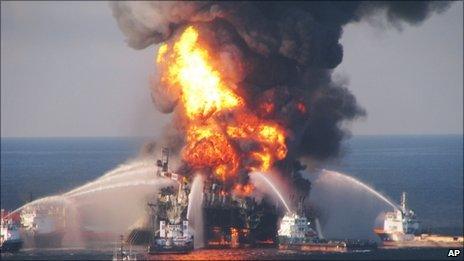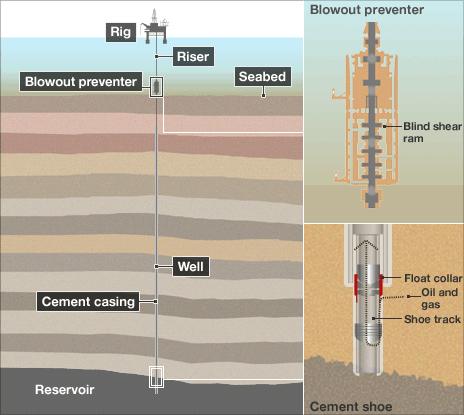BP spreads blame over oil spill
- Published

Eleven people were killed and 17 people were injured in the explosion
A "sequence of failures involving a number of different parties" was to blame for the Deepwater Horizon oil spill in the Gulf of Mexico, BP says.
An investigation carried out by BP said it was responsible in part for the disaster, but it also blamed two other companies working on the well.
However both firms criticised the report.
BP faces billions of dollars worth of legal claims for compensation over the spill, the worst in recent US history.
An estimated 4.9m barrels of oil leaked into the Gulf after the blast.
The well was capped on 15 July, and an operation to permanently seal it is due to take place in the next few weeks.
In the 193-page internal report, external released on its website, BP said that decisions made by "multiple companies and work teams" contributed to the accident, which it said arose from "a complex and interlinked series of mechanical failures, human judgements, engineering design, operational implementation and team interfaces".
BP was leasing the Deepwater Horizon rig from Transocean, and its cement contractor was Halliburton. The BP report was critical of the processes and actions of teams from both firms.
However, in a statement issued after the report, Transocean dismissed BP's criticism, calling the company's own well design "fatally flawed".
"In both its design and construction, BP made a series of cost-saving decisions that increased risk - in some cases, severely," the Associated Press reported Transocean as saying.
Halliburton also criticised the BP report, saying that it had "a number of substantial omissions and inaccuracies".
"Halliburton remains confident that all the work it performed with respect to the Macondo well was completed in accordance with BP's specifications," Cathy Mann, Halliburn's director of corporate affairs, said in a statement.
'Bad cement'
The report, conducted by BP's head of safety, Mark Bly, highlighted eight key failures that, in combination, led to the explosion.
BP said that both BP and Transocean staff incorrectly interpreted a safety test which should have flagged up risks of a blowout.
"Over a 40-minute period, the Transocean rig crew failed to recognise and act on the influx of hydrocarbons into the well" which eventually caused the explosion.
BP criticised the cementing of the well - carried out by Halliburton - and repeated previous criticism of the blowout preventer.
Among the other findings, the report said:
There were "no indications" that Transocean had tested intervention systems at the surface, "as was required by Transocean policy", before they were deployed on the well
"Improved engineering rigour, cement testing and communication of risk" by Halliburton could have identified flaws in cement design and testing, quality assurance and risk assessment
A Transocean rig crew and a team described as "mudloggers" working for Halliburton Sperry Sun may have been distracted by what are described as "end-of-well activities" and, as a result, important monitoring was not carried out for more than seven hours
Crew may have had more time to respond before the explosion if they had diverted escaping fluids overboard.
"To put it simply, there was a bad cement job and a failure of the shoe track barrier at the bottom of the well, which let hydrocarbons from the reservoir into the production casing," said outgoing chief executive Tony Hayward.
"The negative pressure test was accepted when it should not have been, there were failures in well control procedures and in the blowout preventer; and the rig's fire and gas system did not prevent ignition," he said.
The blowout preventer that failed was recovered from the Gulf of Mexico on Saturday and transported to a Nasa facility near New Orleans where it will be placed in the custody of the US Justice Department and examined.
'Lessons for future'
BP's incoming chief executive Bob Dudley said the report proved that the explosion was "a shared responsibility among many entities".
The company said it had accepted all the recommendations in the report, and would implement them worldwide.
"We are determined to learn the lessons for the future and we will be undertaking a broad-scale review to further improve the safety of our operations... to ensure that a tragedy like this can never happen again," Mr Dudley said in a statement.
The environmental group Greenpeace has described the report as revealing "a devastating litany of human error, incompetence and technical failure".
BP's shares rose after the report was published at 1100 GMT (1200 BST).
BP says dealing with the aftermath of the spill has cost $8bn (£5.2bn), and it has already paid out about $399m in claims to people affected by the spill.
The leak caused widespread disruption to jobs in the fishing and tourism industries along the US Gulf Coast.
A national commission is expected to submit a report to President Barack Obama by mid-January next year. A Congressional joint investigation will submit a report later than month.
The US justice department is also investigating the disaster, but its investigations will conclude only when lawyers and investigators have decided whether or not there is evidence of criminal wrongdoing.
The Deepwater Horizon explosion according to BP

19 April - 'Bad' cement pumped down casing to stop gas and oil leaking into welbore
20 April - Gas and oil leak through shoe track barrier and float collar
20 April - Tests carried out on the rig incorrectly suggest pressure is at a safe level
The crew do not recognise there is a major problem or act to control it until the hydrocarbons are flowing rapidly up the riser
The crew close the blowout preventer and diverter, routing oil and gas to the mud gas separator (MGS) system rather than diverting it overboard
The MGS is overwhelmed by the force of oil and gas which leaks into the rig's ventilation system
The heating, ventilation and air conditioning system is thought to have sent a gas-rich mixture into the engine rooms
2149 local time There are two explosions, killing 11 men
April 21 - 22 - The BOP designed to work automatically failed to seal the well as control pods and cutter (blind sheer ram) were not working